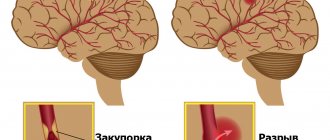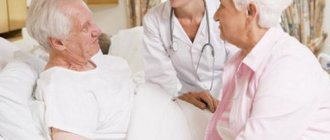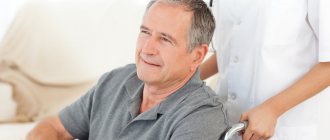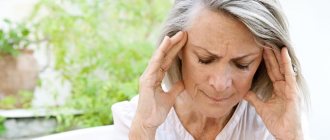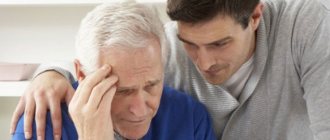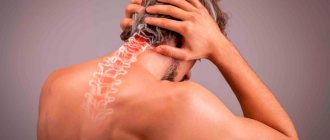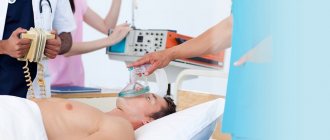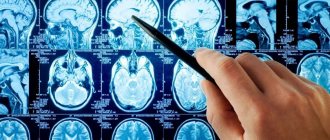Stroke, or acute cerebrovascular accident, remains one of the leading causes of death.
Practice shows that in 60% of cases the lesion is localized in the left brain structures, which control the activity of the right half of the body, where paralysis occurs. Just a few minutes of stopping blood flow is enough to kill millions of neurons and create a dead zone in the nervous tissue. The pathological process involves the pathways of CNS signals to systems and organs on the right.
Kinds
Neurology defines two types of stroke with paralysis of the right side:
- Ischemic stroke. Occurs due to blockage of cerebral vessels by atherosclerotic plaques and blood clots. In the area of circulatory arrest, a focus of brain tissue necrosis occurs. The severity of subsequent paralysis and the ability of the central nervous system to compensate for lost functions depend on its location and size. The disease most often threatens hypertensive patients, diabetics, smokers and anyone with high cholesterol, thrombophlebitis, blood thickening, or problems with heart rhythm. Attacks of tachycardia or atrial fibrillation can provoke the formation of blood clots in the heart cavity, which enter the brain vessels with the blood flow. This type of stroke develops over 2-3 days or longer, so it has specific diagnostic features.
- Hemorrhagic stroke. It is characterized by a rupture of the vascular wall and a breakthrough of blood into the brain tissue, which dies from ischemia. It is provoked by a hypertensive crisis, specific aggregate states of the blood, diseases that cause pathological changes in the structure of blood vessels. Hemorrhagic stroke develops rapidly, quickly causing a coma in the patient. This diagnosis entails the most severe consequences.
The practice of neurology shows that strokes with paralysis of the right side are easier and the consequences are eliminated faster. This is explained by the fact that ischemic stroke more clearly manifests the onset of the disease with characteristic signs. Additional time is provided to recognize the illness and transport the patient to a medical facility. The earlier therapeutic actions are started, the less severe the consequences will be. Neurologists call this the stroke race.
Expert opinion
Author: Ekaterina Dmitrievna Abramova
Neurologist, director of the chronic pain clinic
According to the Federal State Statistics Service, stroke ranks second in the structure of mortality. This is a dangerous neurological disease, the incidence of which is increasing every year. Statistics show that acute cerebrovascular accident occurs in every third person per 1000 population. Stroke in 60% of cases leads to disability. Due to severe complications, 10% of patients completely lose the ability to self-care. The appearance of persistent paralysis is associated with extensive brain damage.
A stroke requires immediate diagnosis and correct treatment. At the Yusupov Hospital, examinations are carried out using the latest medical equipment: CT, MRI. Thanks to them, it is possible to accurately determine the location of the pathological focus. Doctors at the Yusupov Hospital develop an individual treatment and rehabilitation plan for each patient. The drugs are selected in accordance with the latest European recommendations for the treatment of strokes. Conservative treatment can be supplemented with surgical intervention if indicated. In addition, to speed up recovery, physiotherapy and a course of physical therapy are prescribed.
Types of paralysis on the right side
According to the nature and localization of vascular accidents, the types and subtypes of paralysis are classified:
Central paralysis
It develops when the areas of the brain and spinal cord responsible for the function of movement and the state of the neuromuscular complex are damaged. Characterized by specific spastic reactions. With the central form of paralysis, all muscles are affected, which are in constant tension, and when calm they show clonus - rhythmic twitching, mainly in the area of the knees and feet. In many areas, diagnostic reflexes are absent or weakened. Hypertonicity of the muscles causes their painful tightening with a high degree of resistance. This causes painful contractures due to stretching of the tendons. With tension, tremor of the affected limb is often observed. There is a weakening of the facial muscles and articulation disorders. These markers indicate in which part of the brain the pathological focus is located, which subsequently determines the place where restorative measures need to be carried out.
Peripheral paralysis
With this type of stroke, a decrease or absence of neurological reflexes develops. The tone in the muscles is not determined, they atrophy, decrease in mass, patients lose the ability to move, self-care and generally do any activity. The main task is to restore the conduction pathways of impulses from the brain and spinal cord to the neuromuscular system. By the nature of the pathological symptoms and the areas of their location, it is possible to determine which segments of the central nervous system are out of order. For example, damage to the anterior horns of the spinal cord in the region of the 6-7 cervical and first thoracic vertebrae causes peripheral paralysis of the arm. In the lumbar region there is paralysis of the leg. There is atrophy of small muscles - facial, oculomotor, sublingual, laryngeal, tracheal muscles. Accordingly, the process negatively affects the ability to swallow, vision, breathing, etc.
Rehabilitation after a stroke at home
After overcoming the acute period in the hospital, a rehabilitation period begins for a pensioner with a stroke. Relatives need to decide where it is better for an elderly person to undergo a recovery course: at home or in a rehabilitation center.
You may also be interested in the article: How to obtain patronage for an elderly person
If the family has decided to independently care for the patient after a stroke, they need to follow the recommendations of the attending physician and maintain constant contact with specialized specialists: a psychologist, a neurologist, a speech therapist.
At home, a separate place is assigned to a bedridden patient after a stroke. The bed is equipped with an anti-decubitus mattress. A small table is placed nearby, on which essential items are placed: a bottle of water, care products, a table lamp.
Specialists can come to the home 1-2 times a week, work with the patient and teach home methods of conducting developmental activities. The rest of the time, family members carry out the recommended exercises with the pensioner for 10-20 minutes several times a day. During weekly visits, specialists monitor the dynamics of changes, make additions and adjustments.
Motor abilities are restored using a complex of therapeutic exercises. Before performing the exercises, it is advisable for the patient to take a shower or bath to warm up the body. If there are contraindications to taking a bath or other difficulties, the affected areas are warmed with a heating pad. The muscles will be more flexible and there will be no pain.
Examples of gymnastic exercises:
- pulling up while lying on your back, holding the headboard of the bed;
- eye movements left and right, up and down with closed and open eyelids;
- alternately raising the right and left arms and legs;
- bending the knee and grabbing the shin with the hand;
- joint movements of healthy and motionless limbs to the right and left with a rubber ring put on them.
When carrying out therapeutic exercises, the pensioner’s condition is closely monitored. He shouldn't get tired. If such signs are observed, it means that the amount of stress does not correspond to the physical strength of the patient. We need to make an adjustment: reduce the pace and number of exercises.
Speech is restored by memorizing poetry and tongue twisters. At the initial stage, simple children's poems are chosen, which are easier for a pensioner to recite after a stroke. Gradually more complex material is selected.
Looking at family photographs can activate the process of remembering, since it is easier for the patient to recall the past in his memory. An elderly person remembers acquaintances and friends in the images, then the events associated with them. He tries to pronounce the names of the places he has visited, the objects he sees in the images.
Scientists believe that singing has a beneficial effect on people who have suffered a stroke. If they hear singing, sing together with loved ones, speech activity will be restored faster.
For rehabilitation to be successful, an elderly person should not be in a social “vacuum”: you constantly need to communicate with him, talk, ask questions, even if at first he cannot answer them. In this way, the patient’s desire to speak is stimulated, he remembers words and their meaning.
Chess, checkers, and dominoes are used to develop thinking abilities. In a family, even a small child can take part in restoring the health of a grandfather or grandmother by putting together puzzles, mosaics, or playing a board game.
A separate issue is the organization of nutrition for an elderly person after a stroke.
Excluded from use:
- alcoholic drinks;
- fatty and spicy foods;
- coffee, strong tea;
- sweets.
It is advisable to add to the diet:
- drink liquid of at least 1.5 liters. per day;
- increase consumption of fruits and vegetables;
- eat whole grains;
- replace sweets with dried fruits.
Food should consist of useful substances and be easily digestible so that the body is not overloaded.
It is useful to cook boiled vegetables, dishes from lean fish and meat, and porridge with low-fat milk. If there are paresis and problems with swallowing, the patient is fed through a tube with ready-made nutritional mixtures. As soon as the opportunity arises, you need to take the patient for a walk. Staying in the fresh air is good for brain activity, the body receives oxygen and vitamin D, and appetite appears.
You may also be interested in the article: How to choose a private facility for the elderly
The moral atmosphere in the house is of great importance. Patients who receive family support recover faster. If they experience hostility from others or rudeness, the healing process is slowed down. There is no need to criticize and laugh at clumsiness and awkwardness. Only with encouragement will an elderly person develop a strong desire to overcome the disease.
Causes
The main cause of right-sided paralysis is strokes, chronic and then acute disturbances of blood supply in the structures of the left hemisphere. Nerve tissues are very sensitive to hypoxia. And even if the necrotic focus is significantly removed from the brain capsule, paralysis of the right side of the body still occurs. Most often the hand is affected.
A stroke is not a disease that happens suddenly. Its causes accumulate over years, decades, so that when a critical point is reached, one day the scenario of a “vascular catastrophe” unfolds. This leads to:
- Physical inactivity;
- Diet with a predominance of animal fats and proteins;
- Metabolism, carbohydrate and cholesterol status disorders;
- Limited or inadequate sleep;
- Abuse of tobacco, alcohol, drugs;
- Chronic or severe one-time stress.
Eliminating at least half of these causes will allow stroke to be removed from the list of major diseases that most often suffer in our time.
Risk factors for stroke in older people
This disease affects people of all ages, but the most common stroke is in an old person. Doctors believe that the likelihood of pathology increases in those who have reached 60 years of age and doubles with each passing decade. According to statistics, 75% of all recorded strokes occur in people 65 years of age and older. The diagnosis causes serious complications in old age; the body recovers extremely rarely and not completely. The causes of stroke in an old person are most often associated with concomitant diseases that provoke problems with blood vessels. Typically this is:
- Severe hypertension (persistent high blood pressure), complicated by frequent hypertensive crises (3-4 times a year) is one of the most serious risk factors after 80 years.
- Atrial fibrillation (atrial fibrillation), when the heart beats at irregular intervals and provokes the formation of blood clots. During blood circulation, a clot can enter the brain vessels and cause a stroke.
- Increased blood cholesterol levels. With age, lipid metabolism is disrupted in the human body, the amount of cholesterol deposits on the inner walls of blood vessels increases, and blood clots form, complicating normal blood flow and causing stroke.
- Sedentary lifestyle, poor metabolism and obesity. Brittle bones and all kinds of joint diseases cause people over 80 to move less and build up excess fat mass, which, together with other factors, can lead to a stroke.
- Kidney diseases. Disorders of the urinary system have a detrimental effect on blood circulation, thereby increasing the risk of stroke.
- Endocrine diseases, in which an excess of any hormones leads to high blood pressure.
- Diabetes mellitus is an extremely dangerous cause of stroke. With this disease, the patient experiences dehydration of the body; against this background, the walls of blood vessels are deformed, plugs and growths form on their walls, and the blood thickens.
- Acute rheumatic fever is an inflammation of connective tissues, including the lining of blood vessels and the heart.
- A history of myocardial infarction (necrosis of a portion of the heart muscle), present in a patient after 80 years of age, gives a correct prognosis of stroke in an old person.
- Any acute viral infection against the background of a chronic disease can also cause a stroke.
- The most common cause of stroke in an old person is vascular atherosclerosis, in which the resulting plaques block the blood passage and, when they enter the brain, provoke an attack. It happens that a patient can suffer several micro-strokes in succession, but due to their mild symptoms, he does not attach importance to his condition.
Medical scientists have established a pattern that before the age of 80, stroke more often affects women, but after 82–85 years, it affects men.
We recommend
“Hallucinations in old people: causes and solutions” Read more
Symptoms
The signs of the onset of an illness are beyond doubt; not only doctors, but also ordinary people should know them in order to help their loved ones, acquaintances, or just a person on the street who has become ill in time. You should call the emergency room immediately if you experience the following symptoms:
- Sudden loss of speech (or when it becomes slurred);
- Inability to move an arm or leg;
- Inability to smile (the right side of the mouth sags);
- drooping eyelid;
- State of stupefaction, spatial and temporal disorientation, the patient complains of “mess in the head”;
- Severe headache with vomiting, dizziness;
- The extended right leg turns the foot inward;
- The right arm is bent and pressed towards the body.
Symptoms and causes of ischemic stroke on the right side
If blood circulation through the brain is disrupted, in medicine it is customary to call this disease an ischemic stroke, and if a significant part of the vital cells is damaged, it is called a major stroke.
The main cause of the pathology is considered to be thrombosis, or, in simple terms, blockage of blood vessels. And the cause of the blockage is the formation of blood plaques in the arterial route, which complicate or completely block the access of blood.
Find the answer
Are you having any problem? Enter “Symptom” or “Name of the disease” into the form, press Enter and you will find out all the treatment for this problem or disease.
The consequences will be sad, and treatment is accompanied by a long period and various difficulties. Prompt and qualified assistance can give the patient a chance to successfully survive this brain stroke and return to everyday life faster.
Treatment
Thanks to the efforts of healthcare organizers, the system of stroke treatment in Russia has undergone positive changes. It has become the norm to transport patients with suspected cerebral circulatory disorders to an intensive care bed or neurosurgeon's table within three hours. There are 24-hour vascular centers in all major cities. Specialized structures like the Moscow Yusupov Hospital, which have invaluable experience in treating and rehabilitating the most complex neurological diseases, received support.
Treatment for stroke, when the right side is paralyzed, begins in the intensive care unit, where patients are hospitalized urgently. The treatment regimen provides for the normalization of blood circulation in the brain, restoration of respiratory and swallowing functions, and elimination of the threat of convulsive phenomena. The fight against cerebral edema, the normalization of the body’s water and electrolyte balance, and the metabolic processes of the central nervous system are being actively carried out.
The treatment regimen for hemorrhagic stroke with paralysis of the right side is somewhat different. In this case, drugs that eliminate thromboembolism come to the fore. If treatment is started on time, the blood clot is destroyed and impaired blood flow is restored. Thanks to modern medications, it is often possible to completely avoid the consequences of a stroke.
The patient's condition requires normalization of homeostasis, a decrease in the degree of permeability of the vascular walls and the formation of plasmin.
In some cases, blood clots from brain vessels are removed surgically in neurosurgery departments.
Drug therapy
Subsequent treatment occurs with the help of drugs: neuroprotectors, antiplatelet agents, anticoagulants, thrombolytics, defibrinizing enzymes, antihypertensive drugs. The composition and duration of medication may be varied by your doctor. But several drugs must be taken for life to prevent stroke.
Lifestyle
Stroke is a disease in which a person must start life in new conditions. Most people find it difficult to accept their condition, so deep depression is as dangerous a complication as the physical manifestations. Already in the first stages of recovery, much attention is paid to this aspect. Specialists at the Yusupov Hospital - neurodefectologists, neuropsychologists, occupational therapists, rehabilitation specialists, working with patients in groups and individually, help them overcome a depressed, anxious state, gain confidence in their abilities to overcome the disease, and follow the rules of a healthy lifestyle. These are changes in the principles of nutrition with a predominance of vegetable and dairy products, reasonable physical activity, giving up bad habits, training the functions of the nervous, muscular, and cardiovascular systems.
The scientific, material and technical base of the Yusupov Hospital allows patients to undergo rehabilitation procedures using modern equipment that meets European standards. And the friendly, optimistic attitude of rehabilitators helps make sure that the simulator is as important and necessary as the pill.
The cause of the disease was lifestyle. It becomes a means of overcoming it.
Right side massage
Recovery after a stroke with paralysis of the right side with the help of massage begins on the 20th day of illness. This is an average date; the severity of the patient’s condition, age, concomitant diseases, etc. are taken into account.
The first massage sessions begin with gentle stroking of the limbs, back and neck muscles. The intensity of the effect increases from session to session, the massage therapist’s actions are aimed at restoring normal blood circulation and sensitivity in the affected part of the body. If the treatment is well tolerated, a course of manual therapy is subsequently prescribed, which demonstrates good results in a short time. A course of physical therapy, physiotherapeutic, kinesiotherapeutic procedures, and acupuncture to restore limb mobility is recommended.
The Yusupov Hospital has a full range of rehabilitation equipment, including innovative ones, and a staff of highly qualified specialists who are proficient in modern techniques and types of massage and physical therapy. Their efforts, led by the country's best neurologists, are helping people recover from stroke paralysis.
Doctors' recommendations
WHO experts say that prevention helps to avoid up to 80% of premature strokes. For this purpose, doctors recommend:
- Regularly monitor important health indicators: blood pressure, cholesterol, blood sugar levels. Most often, it is an increase in one of these indicators that leads to a sudden stroke.
- Follow the correct diet. Everything that contains fat, carcinogens and preservatives, fried, spicy, coffee is prohibited.
- Exercise for at least half an hour every day. Physical activity helps maintain a healthy heart and blood vessels and help you lose excess weight. Daily exercise eliminates the need to take blood thinning medications.
- Refrain from bad habits. Tobacco is very harmful to the body. Quitting smoking immediately reduces the risk of stroke. The same goes for alcohol.
Author : Alexander Kulakov
Certified physician. Graduated from the Moscow Medical School. Clara Zetkin, Moscow Medical and Dental Institute named after. Evdokimov. Author med. content of the site tvou-voleyball.ru
Fighting bedsores
Bedsores are a dangerous enemy of bedridden patients who have to remain in bed for long periods of time. Bedsores appear in areas that are subject to the greatest pressure - the tailbone, shoulder blades, buttocks, legs, forearms.
The skin here becomes thinner, and zones of necrosis form. The most effective fight against bedsores is prevention. It is important to change body position as often as possible, lay the patient on his side, keep the skin clean, carry out daily hygiene procedures, and treat problem areas with disinfectant and softening solutions.
Bedsores in advanced stages require surgical treatment. There are cases when a patient was saved in intensive care, but then, due to poor care, he died from sepsis that developed from banal bedsores. Nursing after a stroke is exactly the case when an experienced and conscientious nurse is just as important as a doctor. And sometimes it’s even more important.
First aid
You must immediately call the ambulance doctors, and try to clearly and intelligibly explain to the person on duty what happened to the patient. Depending on the nature of the disease, the dispatcher sends different teams of doctors to the address. The patient needs a neurologist; his life depends on whether the dispatcher understands you correctly.
- You should slightly raise the victim's head or place something under it.
- Open the window, loosen the belts and collars.
- Be sure to measure your blood pressure and remember the result.
- Principles of treatment.
A person who has suffered an ischemic stroke has only one chance to survive and restore the vital functions of the body - immediate hospitalization. There are no other chances. If minutes are missed, death or disability will be guaranteed.
Treatment of patients can only be carried out in a hospital setting, where they will be under the close supervision of neurologists and neurosurgeons. Patients who have suffered a major stroke are treated with drugs that reduce blood clotting.
Measures are taken to reduce blood glucose levels, and in severe cases, surgery is necessary. The initial action to save the patient should be magnetic resonance imaging and computed tomography to determine the affected areas of the brain.
The duration of treatment is individual for everyone, depending on the characteristics of the body.
Complications
Neurologists have to deal with numerous complications of the physical and psychological state of a stroke, which include:
- Gross disturbances of mental, cognitive, speech activity;
- Perceptual inhibition;
- Inflammatory phenomena of the bronchopulmonary, genitourinary system due to congestion in an immobilized patient;
- Depressive states with suicidal statements.
These manifestations require the closest attention and active therapy from specialists in various fields.
Reviews of people who used folk remedies, massage, and physiotherapy to treat stroke
The majority of those who left reviews about the treatment of stroke with folk remedies express their positive opinion about herbal medicine, special nutrition, and a set of rehabilitation “at-home” exercises, including massage and physiotherapy. Some write about the complete restoration of body functions within eight months.
People note that “in addition to medications, I went to acupuncture and moved a lot. Over the past 2 years, there have been significant changes, but it has not fully recovered.” Different results depend on the characteristics and degree of brain damage.
Those who have completed courses of treatment, for example, with pine cones, emphasize their “magical properties,” the acceleration of recovery after a stroke: “After 2 months, my husband could already write, speak more or less clearly, and even walk.”
Positive reviews about herbal medicine indicate that the centuries-old traditions of collecting herbs, using decoctions, and infusions have been preserved and remain relevant.
One of the main factors, relatives of patients share their experience, is the general mood, the desire to get well, the fortitude of stroke survivors, support from others, a sensitive, attentive attitude. Then the effect of all the methods and means used is beneficial and leads to a favorable outcome.
Forecasts
Experienced neurologists know that the consequences of a stroke cannot be predicted. It is not for nothing that this disease is translated from Latin as “insidious blow, attack.” Often the most pessimistic forecasts are refuted by the amazing plasticity of the brain, when the load of the dead area is taken on by neighboring and even distant neuron cells. The paralyzed man rises and returns to life. And vice versa: a patient who easily suffered a stroke with a positive prognosis, but returned to his previous lifestyle, receives a new stroke within a year. Already fatal.
In modern medicine, forecasts quickly become outdated, new methods and specializations appear. Yesterday's wheelchair-bound or bedridden patients have the opportunity to be restored using IT technologies, developments in biotechnology that create fundamentally new medicines, innovative tools such as exo-skeletons that teach paralyzed people to walk again. Breakthrough ideas are expected in scientific neurology, which has proven that neurogenesis (the production of new neurons even in the elderly) exists, contrary to popular belief that nerve cells do not regenerate. A method currently being tested for growing neurons from a patient's blood cells holds great promise. Neurologists will be able to repair the brain, replacing diseased areas with new ones. And this fantastic tomorrow is much closer than we can imagine.
Today, a favorable prognosis for the disease for many years depends on many factors. And the main one is the right choice of a medical institution and the choice of a doctor.
Features of right-sided stroke
A stroke of the right hemisphere of the brain is diagnosed as often as a left-sided one, but differs in the degree of manifestation and consequences. This is due to two factors:
- When the right side of the brain is damaged, the left side of the body is paralyzed, which is where the heart is located. Consequently, the patient receives consequences associated not only with brain damage - there will also be problems with cardiac activity.
- Each half of the brain is responsible for a specific set of behaviors and reflexes. If a person is right-handed, then the centers responsible for the ability to navigate in space will suffer. And if left-handed is the speech center
If we consider the symptoms of a stroke on the right side, it will largely depend on the type of stroke and the location of the affected area. The following rules apply here:
- A right-sided stroke is accompanied by cerebral symptoms similar to any type of stroke associated with impaired cerebral circulation. These include disturbances of consciousness, vomiting, severe headaches, dizziness, and breathing problems.
- A hemorrhagic right-sided stroke will have more pronounced disturbances in cerebral symptoms. This is due to direct contact (pressure, acid composition) of blood leaking from a burst vessel onto brain tissue. Hemorrhage causes severe headaches, including loss of consciousness, depression of consciousness and constant vomiting.
- Ischemic right-sided stroke is characterized by mild cerebral symptoms and significant neurological symptoms, depending on the location of the source of damage (blockage of the vascular duct).
Possible consequences
What should a person expect after a right-sided stroke?
This disease is fraught with the following serious consequences:
- Paralysis and paresis. Most often, there is loss of mobility in the left limbs – legs and arms. Problems arise when holding objects in the hand;
- Hypesthesia. Sensitivity and perception of the left side of the body are lost;
- Mental disorders. Inappropriate behavior, excessive excitability, and causeless aggression may appear;
- Amnesia. Usually there are problems with current memory, but old events are not lost. There may be periods of memory loss, loss of orientation in time and place;
- Ophthalmological problems. They are associated with deterioration of vision in the left eye (double image, blurred image).

